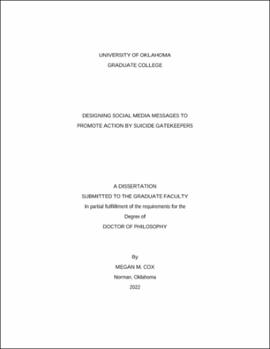| dc.description.abstract | The act of suicide is a tragic and yet prevalent occurrence in the U.S. younger population. Suicide prevention professionals and programs have focused on reaching not only individuals with suicide ideation, but also family, friends, and other acquaintances, who can be referred to as suicide gatekeepers. Social media provide platforms where health communicators can reach a large population. This research focuses on examining and testing the most effective message framing and wording of social media messages for positively influencing suicide gatekeeper intervention behavior on behalf of a friend or peer. The study first used the grounded theory method to collect and analyze data from suicide prevention specialists and online suicide prevention sources targeted to suicide gatekeepers. This research suggests that suicide gatekeepers need to detect suicide, engage suicidal peers in conversation, and connect suicidal peers with resources. In order to motivate suicide gatekeepers, social media messages should debunk current misconceptions with the constructs of significance of suicide threat, preventability of suicide through intervention, and beneficence of discussing suicide with those who have suicide ideation. In addition, message framing of empathy appeals may positively affect suicide gatekeeper state empathy and behavioral expectation.
The second part of this study used an experiment to test the influence of message construct (between subjects) and message frame (within subjects). Using four messages per participant (two gain-framed and two-loss framed), the survey randomized the 1,285 survey participants between the ages of 18 and 34 on two college campuses into the three message construct conditions (significance, preventability, and beneficence). The experiment found that gain-framed messages have a more positive influence on all the message outcome variables compared with loss-framed messages (perceived message effectiveness, self-efficacy, response efficacy, empathy, likelihood of social media message engagement, and behavioral expectation), and empathy mediates the relationship between gain- and loss-framed messages and behavioral expectation. Message construct condition and other mediation results were less substantial, although some evidence suggests that the significance message construct may have some advantages for social media messages designed for suicide gatekeepers. Limitations and areas for future study are discussed. | en_US |
